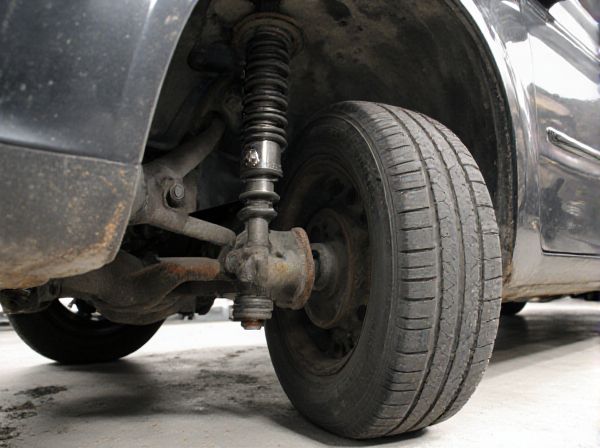
Photo illustration: Solid Axle vs Independent Rear
A solid axle offers durability and simplicity, making it ideal for off-road and heavy-duty applications due to its robust construction and consistent ground clearance. Independent rear suspension enhances ride comfort and handling by allowing each wheel to move independently, improving traction and stability on uneven surfaces. Your choice depends on whether you prioritize rugged performance or smooth, responsive driving dynamics.
Table of Comparison
| Feature | Solid Axle | Independent Rear Suspension |
|---|---|---|
| Design | Single rigid beam connecting both wheels | Each rear wheel moves independently |
| Ride Comfort | Less comfortable; transmits more road shocks | Improved comfort; absorbs road imperfections better |
| Handling | Lower handling precision; wheels linked | Better handling; allows individual wheel movement |
| Durability | Highly durable; simple rugged design | Less durable; complex and sensitive components |
| Cost | Lower manufacturing and maintenance cost | Higher cost due to complexity and parts |
| Weight | Heavier; adds unsprung mass | Lighter; reduces unsprung mass for better performance |
| Common Applications | Trucks, off-road vehicles, heavy-duty cars | Passenger cars, sports cars, performance vehicles |
Introduction to Rear Suspension Types
Rear suspension types primarily include solid axle and independent rear suspension (IRS), each offering distinct performance characteristics for vehicles. Solid axle systems feature a single rigid beam connecting both rear wheels, providing durability and simplicity favored in heavy-duty and off-road vehicles. Independent rear suspension allows each wheel to move independently, enhancing ride comfort, handling, and traction, commonly found in passenger cars and performance vehicles.
What is a Solid Axle?
A solid axle, also known as a live axle, is a single, rigid component that connects both rear wheels, ensuring they move together as one unit. This design provides superior durability and load-bearing capacity, making it ideal for off-road and heavy-duty vehicles. However, it tends to offer less precise handling and ride comfort compared to independent rear suspension systems.
What is an Independent Rear Suspension (IRS)?
Independent Rear Suspension (IRS) allows each rear wheel to move independently, enhancing traction and ride comfort on uneven surfaces. Unlike a solid axle, IRS reduces unsprung weight and improves handling by minimizing wheel hop and maintaining better tire contact with the road. This design is favored in performance and off-road vehicles for superior stability and control.
Key Differences Between Solid Axle and IRS
Solid Axle, also known as a live axle, features a single beam connecting both rear wheels, providing durability and uniform wheel movement, ideal for heavy-duty and off-road vehicles. Independent Rear Suspension (IRS) allows each rear wheel to move independently, enhancing ride comfort, handling, and traction by reducing unsprung weight and improving wheel articulation on uneven terrain. Key differences include IRS offering superior handling and ride quality, while Solid Axle excels in strength, load-bearing capacity, and simplicity of design.
Ride Comfort: Solid Axle vs Independent Rear
Independent rear suspensions provide superior ride comfort by allowing each wheel to move independently, reducing vibrations and improving traction on uneven surfaces. Solid axles, while durable and simpler, transfer more road shocks directly to the chassis, resulting in a harsher ride, especially on rough terrain. Vehicles with independent rear suspension often exhibit better handling and smoother responses, making them ideal for passenger cars and performance-oriented models.
Handling and Stability Comparisons
Solid axle suspension systems provide robust durability and consistent handling in off-road and heavy-load conditions, offering excellent stability due to their rigid connection between wheels. Independent rear suspension enhances handling precision and ride comfort by allowing each wheel to move independently, which improves traction and stability on uneven surfaces and during cornering. Performance vehicles often favor independent rear setups for superior control, while solid axles remain prevalent in trucks prioritizing load-bearing capability and rugged stability.
Off-Road Performance Considerations
Solid axle suspensions provide superior durability and ground clearance, essential for rugged off-road conditions and rock crawling, due to their rigid design and equal load distribution. Independent rear suspensions enhance traction on uneven terrain by allowing each wheel to move independently, improving ride comfort and control but often sacrificing some articulation and strength under extreme stress. Off-road enthusiasts prioritize solid axles for maximum strength and articulation, while independent setups appeal to those seeking better handling and smoother rides on varied landscapes.
Maintenance and Durability Factors
Solid axle systems offer enhanced durability due to their simple, robust design with fewer moving parts, leading to lower maintenance requirements and better longevity under heavy-duty usage. Independent rear suspensions, while providing improved ride comfort and handling, involve more complex components such as multiple joints and bushings that require frequent inspection and maintenance to prevent wear and tear. Maintenance costs for solid axles are generally lower, but independent rear setups may demand higher upkeep to sustain optimal performance and durability over time.
Cost and Complexity Analysis
Solid axle rear suspension systems offer a cost-effective solution with simpler design and fewer components, resulting in lower manufacturing and maintenance expenses compared to independent rear suspension (IRS) setups. Independent rear suspension systems involve more complex engineering, with multiple linkages and joints that increase production costs and require advanced alignment and tuning processes. While IRS provides superior handling and ride comfort, its higher complexity translates to greater initial investment and ongoing maintenance efforts.
Which Rear Suspension is Best?
Solid axle rear suspension offers durability and simplicity, making it ideal for heavy-duty off-road vehicles requiring maximum load-bearing capacity and ease of maintenance. Independent rear suspension (IRS) provides superior ride comfort and handling by allowing each wheel to move independently, enhancing traction and stability on varied terrains for passenger cars and performance vehicles. Choosing the best rear suspension depends on application needs: solid axles favor rugged utility, while IRS excels in ride quality and precision.
 caratoz.com
caratoz.com